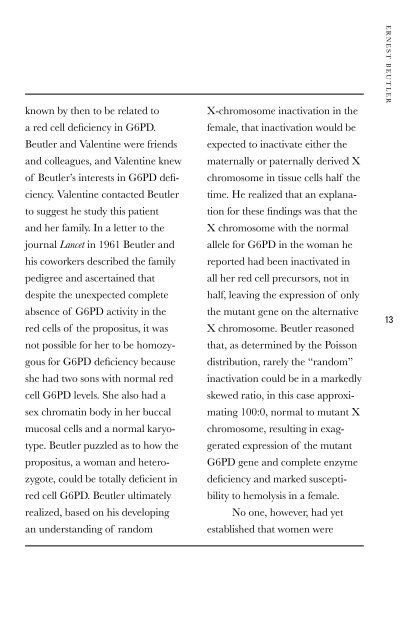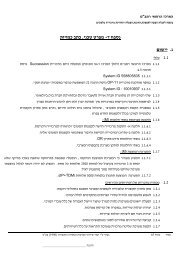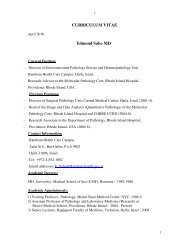ERNEST BEUTLER
ERNEST BEUTLER
ERNEST BEUTLER
Create successful ePaper yourself
Turn your PDF publications into a flip-book with our unique Google optimized e-Paper software.
known by then to be related to<br />
a red cell deficiency in G6PD.<br />
Beutler and Valentine were friends<br />
and colleagues, and Valentine knew<br />
of Beutler’s interests in G6PD deficiency.<br />
Valentine contacted Beutler<br />
to suggest he study this patient<br />
and her family. In a letter to the<br />
journal Lancet in 1961 Beutler and<br />
his coworkers described the family<br />
pedigree and ascertained that<br />
despite the unexpected complete<br />
absence of G6PD activity in the<br />
red cells of the propositus, it was<br />
not possible for her to be homozygous<br />
for G6PD deficiency because<br />
she had two sons with normal red<br />
cell G6PD levels. She also had a<br />
sex chromatin body in her buccal<br />
mucosal cells and a normal karyotype.<br />
Beutler puzzled as to how the<br />
propositus, a woman and heterozygote,<br />
could be totally deficient in<br />
red cell G6PD. Beutler ultimately<br />
realized, based on his developing<br />
an understanding of random<br />
X-chromosome inactivation in the<br />
female, that inactivation would be<br />
expected to inactivate either the<br />
maternally or paternally derived X<br />
chromosome in tissue cells half the<br />
time. He realized that an explanation<br />
for these findings was that the<br />
X chromosome with the normal<br />
allele for G6PD in the woman he<br />
reported had been inactivated in<br />
all her red cell precursors, not in<br />
half, leaving the expression of only<br />
the mutant gene on the alternative<br />
X chromosome. Beutler reasoned<br />
that, as determined by the Poisson<br />
distribution, rarely the “random”<br />
inactivation could be in a markedly<br />
skewed ratio, in this case approximating<br />
100:0, normal to mutant X<br />
chromosome, resulting in exaggerated<br />
expression of the mutant<br />
G6PD gene and complete enzyme<br />
deficiency and marked susceptibility<br />
to hemolysis in a female.<br />
No one, however, had yet<br />
established that women were<br />
Ernest Beutler<br />
13











